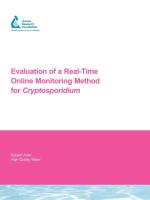- Start
- Evaluation of a Real-Time Online Monitoring Method for Cryptosporidium
Evaluation of a Real-Time Online Monitoring Method for Cryptosporidium
Angebote / Angebote:
The objective of this project was to perform a proof-of-concept for a novel method for real-time, online continuous monitoring of Cryptosporidium in drinking water.
Current methods for the detection and monitoring of Cryptosporidium are slow, labor intensive, and often have high variability and low recoveries. In addition, since the terrorist attack of 9/11, interest in real-time continuous online pathogen monitoring has increased dramatically. Optical techniques, such as the one tested in this project, hold the promise of providing utility-friendly methods of solving the problem of continuously monitoring the biological content of water in real-time.
First, the researchers tested the MALS technology to determine if Cryptosporidium oocysts could be detected in various water types, including purified water, finished drinking water, groundwaters, and raw surface waters. Secondly, they developed optical fingerprints of standard test spheres, Cryptosporidium oocysts, and finished drinking water. Next, the researchers tested the optical fingerprints with blind samples to measure the performance of MALS. After that, they tested the MALS technology to determine if it could discriminate between live oocysts and oocysts that were treated or otherwise physically altered. Finally, the research team developed optical fingerprints of the different types of oocysts: infective and untreated, UV treated, ozone treated, heat treated, and excysted oocyst shells.
Originally published by AwwaRF for its subscribers in 2004.
Folgt in ca. 15 Arbeitstagen



